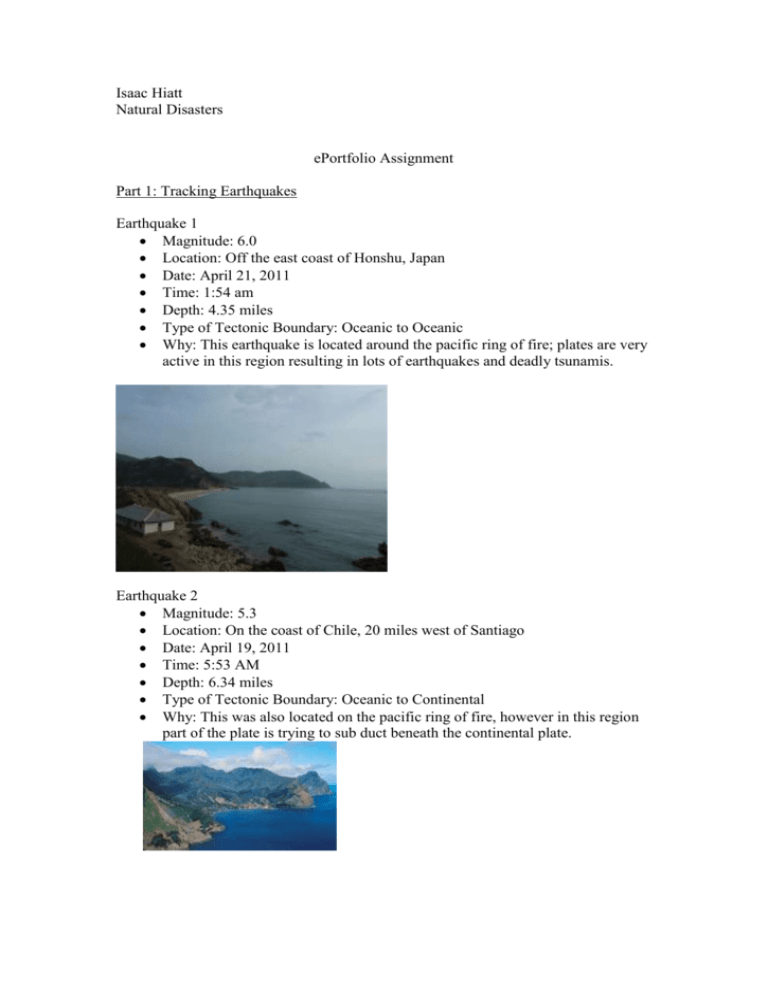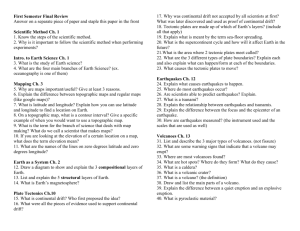Natural Disasters
advertisement

Isaac Hiatt Natural Disasters ePortfolio Assignment Part 1: Tracking Earthquakes Earthquake 1 Magnitude: 6.0 Location: Off the east coast of Honshu, Japan Date: April 21, 2011 Time: 1:54 am Depth: 4.35 miles Type of Tectonic Boundary: Oceanic to Oceanic Why: This earthquake is located around the pacific ring of fire; plates are very active in this region resulting in lots of earthquakes and deadly tsunamis. Earthquake 2 Magnitude: 5.3 Location: On the coast of Chile, 20 miles west of Santiago Date: April 19, 2011 Time: 5:53 AM Depth: 6.34 miles Type of Tectonic Boundary: Oceanic to Continental Why: This was also located on the pacific ring of fire, however in this region part of the plate is trying to sub duct beneath the continental plate. Earthquake 3 Magnitude: 4.1 Location: Mojave Desert Nevada Date: April 16, 2011 Time: 9:46 AM Depth: 8.14 miles Type of Tectonic Boundary: Transform Why: This is along a mountain range that was formed by plates sliding past one another and this is a result of built up pressure. Earthquake 4 Magnitude: 5.0 Location: Tibet Border Region Date: April 20, 2011 Time: 4:27 PM Depth: 9.69 miles Type of Tectonic Boundary: Continental to Continental Why: This is in an area where mountain ranges were formed by continental plates pushing toward each other and they haven’t stopped moving. Earthquake 5 Magnitude: 4.8 Location: Northern Mid-Atlantic Ridge Date: April 19, 2011 Time: 8:30 PM Depth: 6.34 miles Type of Tectonic Boundary: Divergent Why: This is in area where plates have been moving away from each other and this earthquake shows further movement. Part 2: Identifying Volcanoes Volcano 1 Name: Mt. Rainier Type of volcano: Composite Volcano Type of tectonic boundary: oceanic to continental Volcano 2 Name: Skjaldbreiaur, Iceland Type of Volcano: Shield Volcano Type of tectonic boundary: Hotspot Volcano 3 Name: Paricutin Type of Volcano: Cinder Volcano Type of tectonic boundary: Hotspot Volcano 4 Name: Yellowstone Caldera Type of Volcano: Caldera Type of Tectonic boundary: Hotspot Part 3: Assignment Reflection The correlation between earthquakes and volcanoes with regard to the theory of plate tectonics is that because of movement going on in the different plates openings to magma chambers are being exposed creating hotspots or volcanoes. The spatial relationship is quite close, usually where ever there is an area with a lot of earthquakes there is bound to be volcanoes nearby. I didn’t realize just how frequent earthquakes take place. For some reason I thought that they were few and in between, but in fact they are happening every day. Volcanoes are amazingly destructive when they erupt. They contain as much energy as hundreds of atomic bombs. They main thing I’ve gotten out of this course is that as human beings we need to respect mother nature more and not try to contain her as much as we do. We need to be smarter about how treat the earth because we can contribute to our own destruction. Also I’ve come to think that when disasters happen its all part of the earth’s own growing process.








